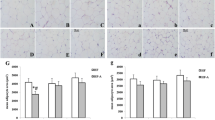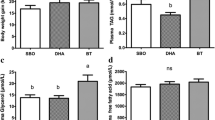Abstract
Docosahexaenoic acid (DHA) is one kind of ω-3 polyunsaturated fatty acids (PUFAs) and plays an important role in lipid metabolism. In this research, mice were daily intragastric administrated with DHA for 3 weeks. Subcutaneous adipose tissue and liver were separated every week, RNA was extracted. Peroxisome proliferator-activated receptor (PPARγ), Sterol regulatory element binding protein-1c (SREBP-1c), Fatty acid synthetase (FAS), Hormone sensitive lipase (HSL) and triglyceride hydrolase TGH genes expression were detected by quantitative PCR. Data showed that, DHA up-regulated PPARγ, HSL and TGH in adipose tissue, but it had no effect on SREBP-1c and FAS expression. However, in liver there were some differences in regulating these genes. PPARγ, SREBP-1c and FAS were down-regulated, HSL was up-regulated and TGH had no change. These results indicated that DHA played different regulating roles in lipid metabolism in different tissues. In adipose tissue, DHA increased the expression of lipogenesis and lipolysis genes. In liver lipogenesis genes were decreased, but lipolysis genes were increased by DHA. In conclusion, DHA could reduce body fat mass through regulating lipogenesis and lipolysis genes.











Similar content being viewed by others
References
Tanaka K, Shimizu T, Ohtsuka Y, Yamashiro Y, Oshida K (2007) Early dietary treatments with Lorenzo’s oil and docosahexaenoic acid for neurological development in a case with Zellweger syndrome. Brain Dev 29:586–589. doi:10.1016/j.braindev.2007.02.005
Innis SM (2007) Dietary (n-3) fatty acids and brain development. J Nutr 137:855–859
Peyron-Caso E, Taverna M, Guerre-Millo M, Veronese A, Pacher N, Slama G, Rizkalla SW (2002) Dietary (n-3) polyunsaturated fatty acids up-regulate plasma leptin in insulin-resistant rats. J Nutr 132(8):2235–2240
Khan S, Minihane AM, Talmud PJ, Wright JW, Murphy MC, Williams CM, Griffin BA (2002) Dietary long-chain n-3 PUF as increase LPL gene expression in adipose tissue of subjects with an atherogenic lipoprotein phenotype. J Lipid Res 43:979–985
Peyron-Caso E, Quignard-Boulange A, Laromiguiere M, Feing-Kwon-Chan S, Veronese A, Ardouin B, Slama G, Rizkalla SW (2003) Dietary fish oil increases lipid mobilization but does not decrease lipid storage-related enzyme activities in adipose tissue of insulin-resistant, sucrose-fed rats. J Nutr 133(7):2239–2243
Hsu JM, Wang PH, Liu BH, Ding ST (2004) The effect of dietary docosahexaenoic acid on the expression of porcine lipid metabolism-related genes. J Anim Sci 82:683–689
Jump DB (2002) The biochemistry of n-3 polyunsaturated fatty acids. J Biol Chem 277:8755–8758. doi:10.1074/jbc.R100062200
Gregoire FM, Smas CM, Sul HS (1998) Understanding adipocyte differentiation. Physiol Rev 78:783–809
Yen CF, Jiang YN, Shen TF, Wong IM, Chen CC, Chen KC, Chang WC, Tsao YK, Ding ST (2005) Cloning and expression of the genes associated with lipid metabolism in Tsaiya ducks. Poult Sci 84(1):67–74
Deng X, Elam MB, Wilcox HG, Cagen LM, Park EA, Raghow R, Patel D, Kumar P, Sheybani A, Russell JC (2004) Dietary olive oil and menhaden oil mitigate induction of lipogenesis. Endocrinology 145(12):5847–5861. doi:10.1210/en.2004-0371
Mckenney JM, Sica D (2007) Prescription omega-3 fatty acids for the treatment of hypertriglyceridemia. Am J Health Syst Pharm 64:595–605. doi:10.2146/ajhp060164
Siddiqui RA, Harvey KA, Zaloga GP (2008) Modulation of enzymatic activities by n-3 polyunsaturated fatty acids to support cardiovascular health. J Nutr Biochem 19(7):417–437. doi:10.1016/j.jnutbio.2007.07.001
Abeywardena MY, Head RJ (2001) Longchain n-3 polyunsaturated fatty acids and blood vessel function. Cardiovasc Res 52:361–371. doi:10.1016/S0008-6363(01)00406-0
Kersten S, Desvergne B, Wahli W (2000) Roles of PPARs in health and disease. Nature 405:421–424. doi:10.1038/35013000
Chambrier C, Bastard JP, Rieusset J, Chevillotte E, Bonnefont-Rousselot D, Therond P, Hainque B, Riou JP, Laville M, Vidal H (2002) Eicosapentaenoic acid induces mRNA expression of peroxisome proliferator-activated receptor γ. Obes Res 10:518–525. doi:10.1038/oby.2002.70
Spurlock ME, Houseknecht KL, Portocarrero CP, Cornelius SG, Willis GM, Bidwell CA (2000) Regulation of PPARγ but not obese gene expression by dietary fat supplementation. J Nutr Biochem 11:260–266. doi:10.1016/S0955-2863(00)00076-0
Trombetta A, Maggiora M, Martinasso G, Cotogni P, Canuto RA, Muzio G (2007) Arachidonic and docosahexaenoic acids reduce the growth of A549 human lung-tumor cells increasing lipid peroxidation and PPARs. Chem Biol Interact 165:239–250. doi:10.1016/j.cbi.2006.12.014
Madsen L, Petersen RK, Kristiansen K (2005) Regulation of adipocyte differentiation and function by polyunsaturated fatty acids. Biochim Biophys Acta 1740:266–286
Nakatani T, Kim HJ, Kaburagi Y, Yasuda K, Ezaki O (2003) A low fish oil inhibits SREBP-1 proteolytic cascade, while a high-fish-oil feeding decreases SREBP-1 mRNA in mice liver: relationship to anti-obesity. J Lipid Res 44:369–379. doi:10.1194/jlr.M200289-JLR200
Yoshikawa T, Shimano H, Yahagi N, Ide T, Amemiya-Kudo M, Matsuzaka T et al (2002) Polyunsaturated fatty acids suppress sterol regulatory element-binding protein 1c promoter activity by inhibition of liver X receptor (LXR) binding to LXR response elements. J Biol Chem 277(3):1705–1711. doi:10.1074/jbc.M105711200
Kim HJ, Takahashi M, Ezaki O (1999) Fish oil feeding decreases mature sterol regulatory element-binding protein 1 (SREBP-1) by down-regulation of SREBP-1c mRNA in mouse liver. A possible mechanism for down-regulation of lipogenic enzyme mRNAs. J Biol Chem 274(36):25892–25898. doi:10.1074/jbc.274.36.25892
Ou J, Tu H, Shan B, Luk A, DeBose-Boyd RA, Bashmakov Y et al (2001) Unsaturated fatty acids inhibit transcription of the sterol regulatory element-binding protein-1c (SREBP-1c) gene by antagonizing ligand-dependent activation of the LXR. Proc Natl Acad Sci USA 98(11):6027–6032. doi:10.1073/pnas.111138698
Xu J, Teran-Garcia M, Park JHY, Nakamura MT, Clarke SD (2001) Polyunsaturated fatty acids suppress hepatic sterol regulatory element-binding protein-1 expression by accelerating transcript decay. J Biol Chem 276:9800–9807. doi:10.1074/jbc.M008973200
Ou J, Luong A, Goldstein JL, Brown MS (2001) Unsaturated fatty acids down-regulate srebp isoforms 1a and 1c by two mechanisms in HEK-293 cells. J Biol Chem 276(6):4365–4372. doi:10.1074/jbc.M007273200
Mater MK, Thelen AP, Pan DA, Jump DB (1999) Sterol response element-binding protein 1c (SREBP-1c) is involved in the polyunsaturated fatty acid suppression of hepatic S14 gene transcription. J Biol Chem 274(46):32725–32732. doi:10.1074/jbc.274.46.32725
Xu J, Cho H, Malley SO, Park JHY, Clarke SD (2002) Dietary polyunsaturated fats regulate rat liver sterol regulatory element binding proteins-1 and -2 in three distinct stages and by different mechanisms. J Nutr 132:3333–3339
Sekiya M, Yahagi N, Matsuzaka T, Najinma Y, Nakakuki M, Nagai R, Ishibashi S, Osuga J, Yamada N, Shimano H (2003) Polyunsaturated fatty acids ameliorate hepatic steatosis in obese mice by SREBP-1 suppression. Hepatology 38:1529–1539
Peterson DG, Matitashvili EA, Bauman DE (2004) The inhibitory effect of trans-10, cis-12 CLA on lipid synthesis in bovine mammary epithelial cells involves reduced proteolytic activation of the transcription factor SREBP-1. J Nutr 134:2523–2527
Kraemer FB, Shen WJ (2002) Hormone-sensitive lipase: control of intracellular tri-(di-) acylglycerol and cholesteryl ester hydrolysis. J Lipid Res 43:1585–1594. doi:10.1194/jlr.R200009-JLR200
Osuga JI, Ishibashi S, Oka T, Yagyu H, Tozawa R, Fujimoto A, Shionoiri F, Yahagi N, Kraemer FB, Tsutsumi O (2000) Targeted disruption of hormone-sensitive lipase results in male sterility and adipocyte hypertrophy, but not in obesity. Proc Natl Acad Sci USA 97:787–792. doi:10.1073/pnas.97.2.787
Zimmermann R, Strauss JG, Haemmerle G, Schoiswohl G, Birner-Gruenberger R, Riederer M, Lass A, Neuberger G, Eisenhaber F, Hermetter A, Zechner R (2004) Fat mobilization in adipose tissue is promoted by adipose triglyceride lipase. Science 306:1383–1386. doi:10.1126/science.1100747
Jenkins CM, Mancuso DJ, Yan W, Sims HF, Gibson B, Gross RW (2004) Identification, cloning, expression, and purification of three novel human calcium-independent phospholipase A2 family members possessing triacylglycerol lipase and acylglycerol transacylase activities. J Biol Chem 279(47):48968–48975. doi:10.1074/jbc.M407841200
Gilham D, Ho S, Rasouli M, Martres P, Vance DE, Lehner R (2003) Inhibitors of hepatic microsomal triacylglycerol hydrolase decrease very low density lipoprotein secretion. FASEB J 17:1685–1687
Shen WJ, Patel S, Yu Z, Jue D, Kraemer FB (2007) Effects of rosiglitazone and high fat diet on lipase/esterase expression in adipose tissue. Biochim Biophys Acta 1771:177–184
Dolinsky VW, Gilham D, Hatch GM, Agellon LB, Lehner R, Vance DE (2003) Regulation of triacylglycerol hydrolase expression by dietary fatty acids and peroxisomal proliferator-activated receptors. Biochim Biophys Acta 1635:20–28
Acknowledgments
This work was supported by a grant from The National Nature Science Foundation of China (30871785), Program for New Century Excellent Talents in University of the Chinese Ministry of Education (NCET-06-0865) and the key Project of Chinese Ministry of Education (105167).
Author information
Authors and Affiliations
Corresponding author
Rights and permissions
About this article
Cite this article
Sun, C., Wei, Zw. & Li, Y. DHA regulates lipogenesis and lipolysis genes in mice adipose and liver. Mol Biol Rep 38, 731–737 (2011). https://doi.org/10.1007/s11033-010-0160-9
Received:
Accepted:
Published:
Issue Date:
DOI: https://doi.org/10.1007/s11033-010-0160-9




